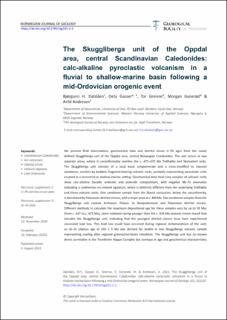The Skuggliberga unit of the Oppdal area, central Scandinavian Caledonides: Calc-alkaline pyroclastic volcanism in a fluvial to shallow-marine basin following a mid-ordovician orogenic event
Peer reviewed, Journal article
Published version
Permanent lenke
https://hdl.handle.net/11250/2833158Utgivelsesdato
2021Metadata
Vis full innførselSamlinger
- Import fra CRIStin [3604]
- Institutt for miljø- og naturvitskap [528]
Originalversjon
Dalslåen, B. H., Gasser, D., Grenne, T., Ganerød, M., & Andresen, A. (2021). The Skuggliberga unit of the Oppdal area, central Scandinavian Caledonides: calc-alkaline pyroclastic volcanism in a fluvial to shallow-marine basin following a mid-Ordovician orogenic event. Norwegian Journal of Geology. 10.17850/njg101-2-2Sammendrag
We present field observations, geochemical data and detrital zircon U–Pb ages from the newly defined Skuggliberga unit of the Oppdal area, central Norwegian Caledonides. The unit occurs in two separate areas, where it unconformably overlies the c. 475–470 Ma Trollhøtta and Skarvatnet units. The Skuggliberga unit consists of a local basal conglomerate and a cross-stratified to massive sandstone, overlain by bedded, fragment-bearing volcanic rocks, probably representing pyroclastic units erupted in a terrestrial or shallow-marine setting. Geochemical data from nine samples of volcanic rocks show calc-alkaline basaltic andesitic and andesitic compositions, with negative Nb–Ta anomalies indicating a continental arc-related signature, which is distinctly different from the underlying Trollhøtta and Kinna volcanic rocks. One sandstone sample from the Skaret succession, below the unconformity, is dominated by Palaeozoic detrital zircons, with a major peak at c. 490 Ma. Two sandstone samples from the Skuggliberga unit contain Archaean, Palaeo- to Neoproterozoic and Palaeozoic detrital zircons. Different methods to calculate the maximum depositional age for these samples vary by up to 50 Myr (from c. 427 to c. 475 Ma), some estimates being younger than the c. 435 Ma plutonic Innset massif that intrudes the Skuggliberga unit, indicating that the youngest detrital zircons must have experienced concealed lead loss. This lead loss could have occurred during regional metamorphism of the unit; an Ar–Ar plateau age of 416 ± 3 Ma was derived for biotite in one Skuggliberga volcanic sample representing cooling after regional greenschist-facies metamorphism. The Skuggliberga unit has no known direct correlative in the Trondheim Nappe Complex but overlaps in age and geochemical characteristics with arc-related plutonic rocks along the central Norwegian coast, indicating that it represents the surface expression of the latter. The orogenic phase predating Skuggliberga deposition is probably related to Taconian accretionary events along the Laurentian margin.

